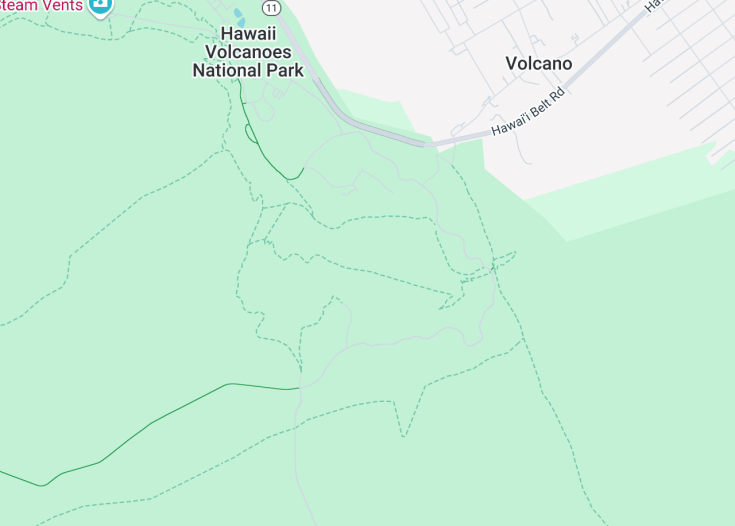Nestled within Hawaii Volcanoes National Park, Kilauea Iki Crater stands as a dramatic testimony to the island’s volcanic activity. In 1959, this now tranquil crater was a fiery cauldron of molten lava, attracting global attention. Today, visitors can hike the well-marked Kilauea Iki Trail, which takes them through both lush rainforests and across the solidified lava lake — starkly contrasting ecosystems side by side. The area provides exceptional insights into geological processes and the natural beauty resulting from volcanic activity.
To fully appreciate the crater’s scale and its natural surroundings, start your visit early in the morning to avoid crowds and experience a cooler, more comfortable hike.
When planning your hike on the Kilauea Iki Trail, wear sturdy hiking boots and bring plenty of water, sunscreen, and a hat to navigate the rugged terrain and variable weather conditions effectively.
Kilauea Iki Crater: A volcanic wonderland
Located within Hawaii Volcanoes National Park, Kilauea Iki Crater offers a unique and thrilling experience for those fascinated by volcanic activity and natural scenery. This crater, once a vibrant lava lake in the eruption of 1959, is now a solidified basaltic field surrounded by lush rainforest. The cooling of the crater’s surface, contrasted with ongoing steam vents and the warm ground beneath, makes for an intriguing visit. The landscape around Kilauea Iki is marked by a stark contrast between the rejuvenating forest flora and the blackened, seemingly barren lunar landscapes left by historic eruptions. This place is not only a haven for geologists and nature lovers but also attracts hikers and photographers drawn by its stark beauty and the chance to walk on what was once molten rock. For anyone visiting the island of Hawaii, a trip to Kilauea Iki Crater is an essential destination, providing a firsthand look at the island’s dynamic geological activity and natural regeneration over decades.
Exploring the depths of Kilauea Iki
The main attraction of Kilauea Iki Crater is undoubtedly its famous hiking trail. This four-mile loop descends from the rim of the crater to its floor, allowing hikers to experience the warmth of the still-cooling ground and witness the steam vents up close. The trail provides stunning views of the surrounding rainforest and the neighboring Halema’uma’u Crater. Along the hike, visitors can learn about the volcano’s eruption history from informative placards and observe various geological features, such as cinder cones and lava flows. Additionally, Kilauea Iki offers panoramic viewpoints perfect for capturing breathtaking photographs of the distinctive volcanic landscape.
Notable features at Kilauea Iki Crater
Perhaps one of the most mesmerizing features of Kilauea Iki Crater is the Thurston Lava Tube, located nearby. This large tube, formed by flowing lava which later drained away, leaving a tunnel-like cavity, offers a peek into the inner workings of volcanic activity. Visitors can walk through the tube, observing the interesting rock formations and residue left by the lava. The ambient, cool air inside contrasts sharply with the warm volcanic ground, making it a memorable part of the crater exploration experience.
Explore the Thrills of Kilauea Iki Crater
kilauea Iki Crater is ideal for the adventurous spirit seeking an extraordinary hiking experience. If you relish natural wonders and breathtaking landscapes, this is the destination for you. Walking through this giant crater provides not only a captivating walk on solidified lava but also a journey through an awe-inspiring volcanic landscape that stimulates a sense of wonder in children, intrigues couples, and offers an exhilarating challenge for the more seasoned outdoor enthusiasts.
Visitors can expect to dive into a blend of geological wonder and educational journey through the unique ecosystem created after the massive 1959 eruption. As you traverse the crater, you’ll see native plant species that have adapted to thrive in such harsh conditions, and perhaps even catch a glimpse of some of the local wildlife. The combination of geological features, panoramic views, and natural diversity makes Kilauea Iki Crater a captivating visit.
Discover the Best Times to Visit Kilauea Iki Crater
The best time to visit Kilauea Iki Crater is during the dry season from May to October. These months offer pleasant weather which is ideal for hiking and exploring the crater. Visitors will experience fewer rains and clearer trails during these months, making it safer and more comfortable for the hike.
Annual Cultural Events
Join the Volcano Festival, usually held in mid-autumn. This event celebrates local culture, featuring traditional crafts, performances and talks about the volcanic landscape and its cultural significances.
Accessibility and Limitations at Kilauea Iki Crater
Knowing about accessibility and limitations is crucial before planning your visit.
Accessibility
Kilauea Iki Crater offers limited accessibility features. There are designated pathways suitable for those with mobility limitations, however, the rugged nature of some trails might pose challenges.
Limitations
- Drone flying is prohibited
- Off-trail hiking is not allowed
- Pet access is restricted to specific areas only
Notes to visitors
- Weather conditions can change rapidly; be prepared with appropriate gear
- Preserve the natural habitat by not removing any natural elements
General Information for Your Visit to Kilauea Iki Crater
Location Close to Nature
Nestled deep in the heart of Hawai’i Volcanoes National Park, Kilauea Iki Crater is surrounded by native rainforests and volcanic landscapes. The site offers an immersive nature experience that is both thrilling and educational.
Address: Kilauea Iki Overlook, Hawaiʻi Volcanoes National Park, HI 96718, USA
Opening Hours for Your Adventure
The park is open year-round, 24 hours a day. However, certain trails and sections may have specific timings, so checking in advance is recommended.
Reaching the Heart of Volcano Country
Car
Driving is the most convenient way to reach Kilauea Iki Crater, with ample parking available near the main trailheads.
| Route | Distance | Travel Time |
|---|---|---|
| From Hilo | 30 miles (48 km) | 45 minutes |
| From Kona | 96 miles (154 km) | 2 hours, 15 minutes |
| From Waikoloa | 70 miles (113 km) | 1 hour, 50 minutes |
Public Transport
Public buses run from major towns to Hawai’i Volcanoes National Park visitor center, and from there, local shuttles are available to the trailheads.
Here are the travel times:
| From | Travel Time |
|---|---|
| Hilo | 1 hour, 20 minutes |
| Kona | 2 hours, 30 minutes |
| Waikoloa | 2 hours |
More Attractions Nearby
Enhance your visit by exploring these attractions, all within close proximity:
- Hawai’i Volcanoes National Park Visitor Center – 2 miles (3.2 km)
- Thurston Lava Tube – 3 miles (4.8 km)
- Jaggar Museum – 4 miles (6.4 km)
- Volcano Art Center – 2 miles (3.2 km)
- Steam Vents – 5 miles (8 km)
- Chain of Craters Road – 6 miles (9.7 km)
- Devastation Trail – 6 miles (9.7 km)
- Lava Viewing Area – 10 miles (16 km)
- Volcano Vineyards – 12 miles (19 km)
- Black Sand Beach – 20 miles (32 km)
- Green Sand Beach – 35 miles (56 km)
- Akaka Falls – 45 miles (72 km)
Common Questions
What are the main features of Kilauea Iki Crater?
What kind of wildlife can be seen at Kilauea Iki Crater?
What hiking opportunities are available around Kilauea Iki Crater?
Are there any safety concerns while visiting Kilauea Iki Crater?
What is the geological significance of Kilauea Iki Crater?
Can you visit Kilauea Iki Crater at any time of the year?
What educational programs are available at Kilauea Iki Crater?
How does Kilauea Iki Crater fit into the wider ecosystem of Hawaii Volcanoes National Park?

Is the Kilauea Iki Crater in Volcano worth visiting?
Located within the renowned Hawaii Volcanoes National Park, the Kilauea Iki Crater presents a unique glimpse into the raw beauty and power of nature. In 1959, this crater was the site of a monumental eruption, creating a fascinating landscape for visitors today. The 4-mile hike across the crater floor offers remarkable views and an up-close experience with volcanic geology.
However, it’s important to consider the physical demands of the hike and the unpredictable weather conditions, which can be challenging for some. The terrain can be rough, with loose volcanic rock, and sudden rain showers are common. Despite these challenges, the awe-inspiring scenery and educational opportunities about volcanic activity make Kilauea Iki Crater a worthwhile visit for those who are adequately prepared and interested in nature and geology.










